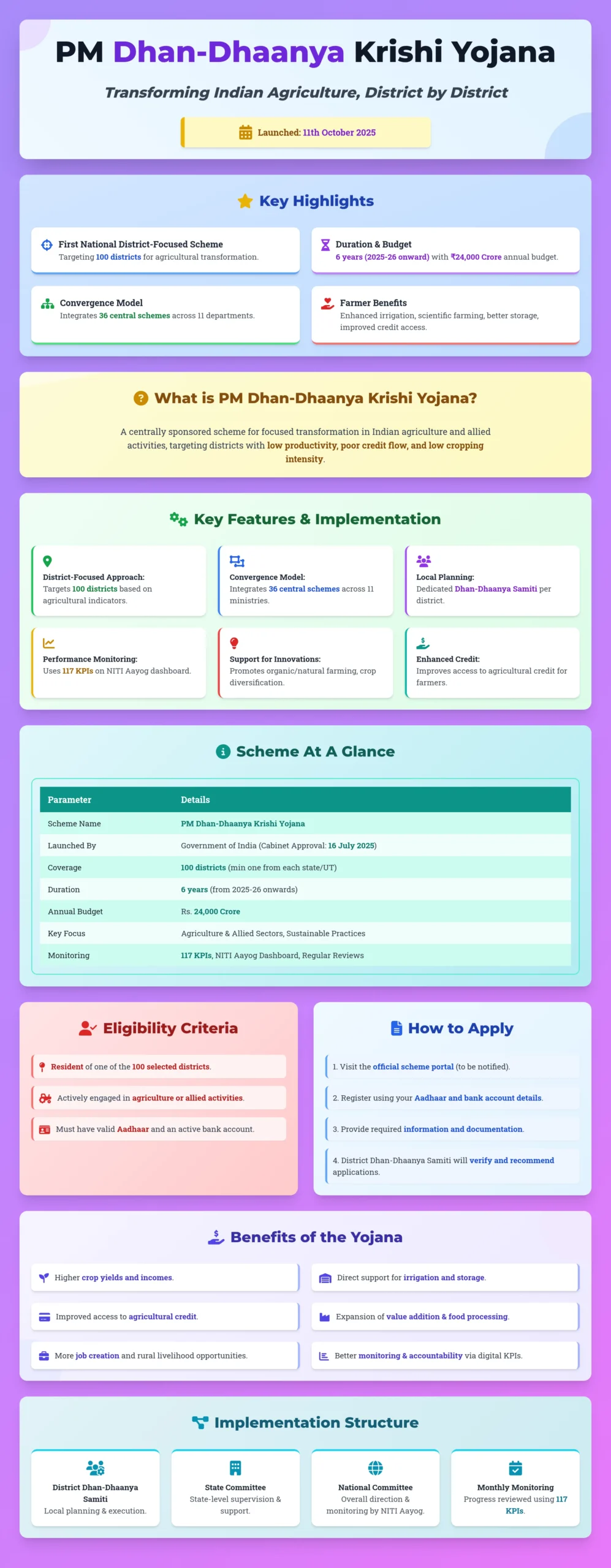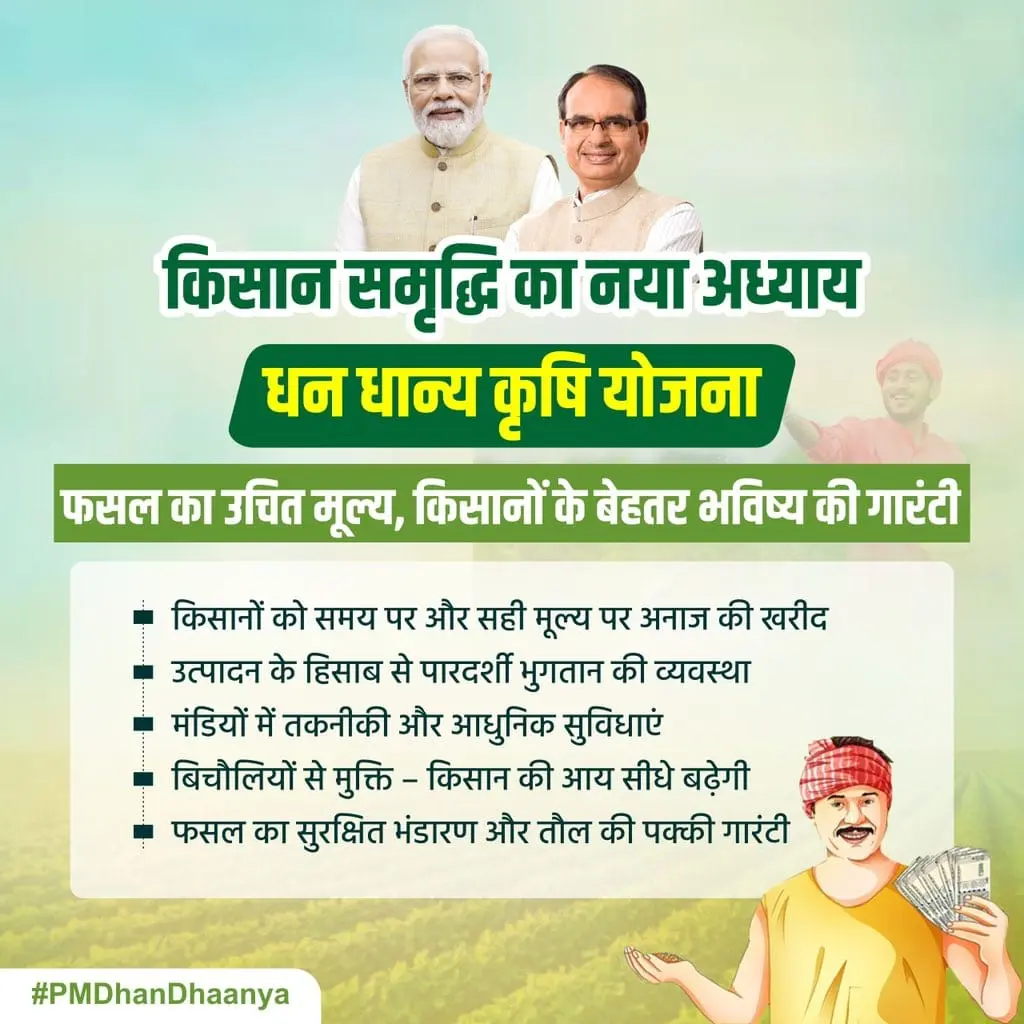- PM Dhan-Dhaanya Krishi Yojana 2025 is India’s first national district-focused scheme to transform agriculture and allied sectors, targeting 100 districts scientifically chosen for low productivity and low credit flow.
- The scheme will run for six years (2025-26 onward) with an annual budget of Rs. 24,000 Crore , converging 36 central schemes across 11 departments, and leveraging state and private sector participation.
- Farmers and agri-entrepreneurs will benefit from enhanced irrigation, scientific farming support, better storage, improved credit access, and regular monitoring via 117 KPIs on a central dashboard.
PM Dhan-Dhaanya Krishi Yojana is a new scheme of the Government of India, approved by the Union Cabinet in July 2025 and launched on 11th October 2025. The scheme aims for rapid, targeted growth of agriculture and allied sectors in 100 selected districts across the country. Inspired by the Aspirational Districts Programme of NITI Aayog, it is the first national scheme focusing exclusively on agricultural transformation at the district level. The scheme will be implemented for six years starting from 2025-26 with an annual outlay of Rs. 24,000 crore.
Latest Update: PM Dhan Dhaanya Krishi Yojana has been launched on 11th October 2025.

What is PM Dhan-Dhaanya Krishi Yojana?
PM Dhan-Dhaanya Krishi Yojana is a centrally sponsored scheme designed to bring focused transformation in Indian agriculture and allied activities, particularly in those districts with low productivity, poor credit flow, and low cropping intensity.
The selection of districts is done scientifically to ensure maximum impact and at least one district from every State and UT is included.

Also Read: Pradhan Mantri Krishi Sinchai Yojana (PMKSY)
Key Features & Implementation
- District-Focused Approach: The scheme targets 100 districts based on agricultural indicators.
- Convergence Model: Integrates resources from 36 existing central schemes under 11 ministries/departments, in partnership with states and private sector.
- Local Planning: Each district will have a dedicated Dhan-Dhaanya Samiti including officials, experts, and progressive farmers to prepare and execute a district-specific plan.
- Minimum Representation: At least one district from each state/UT is included.
- Performance Monitoring: Uses 117 Key Performance Indicators (KPIs), tracked monthly through a dedicated NITI Aayog dashboard. Progress is reviewed at national, state, and district levels.
- Support for Innovations: Promotes local innovations, organic/natural farming, and crop diversification.
- Strengthening Infrastructure: Major focus on improving post-harvest storage, irrigation facilities, and water management at panchayat and block levels.
- Enhanced Credit: Improves access to both short-term and long-term agricultural credit for farmers.
| Parameter | Details |
|---|---|
| Scheme Name | PM Dhan-Dhaanya Krishi Yojana |
| Launched By | Government of India (Cabinet Approval: 16 July 2025), Launch Date 11 October 2025 |
| Coverage | 100 districts (minimum one from each state/UT) |
| Duration | 6 years (from 2025-26 onwards) |
| Annual Budget | Rs. 24,000 Crore |
| Key Focus | Agriculture & Allied Sectors, Sustainable Practices |
| Implementation | Convergence of 36 schemes, state/private participation, local planning |
| District Selection Criteria | Low productivity, low cropping intensity, low credit flow |
| Monitoring | 117 KPIs, NITI Aayog Dashboard, Regular Reviews |
| Main Objective | Enhance productivity, diversify crops, expand natural farming |
Eligibility Criteria
- Applicant must be a farmer or agri-entrepreneur residing in one of the 100 selected districts.
- Should be actively engaged in agriculture or allied activities.
- Must have valid Aadhaar and an active bank account.
How to Apply for PM Dhan-Dhaanya Krishi Yojana
- Visit the official scheme portal (to be notified soon; current updates may be found on pmkisan.gov.in or through district agriculture offices).
- Register using your Aadhaar and bank account details.
- Provide required information and documentation as per guidelines announced for your district.
- District Dhan-Dhaanya Samiti will verify and recommend applications for benefits under the scheme.
Benefits of PM Dhan-Dhaanya Krishi Yojana
- Higher crop yields and incomes due to scientific farming and district-focused planning.
- Direct support for irrigation, storage, and value-addition facilities.
- Improved access to agricultural credit, especially for small and marginal farmers.
- Expansion of value addition and food processing in rural areas.
- More job creation and rural livelihood opportunities.
- Regular hand-holding by government agencies and expert farmers.
- Better monitoring and accountability through digital KPIs dashboard.
Implementation Structure
- District Dhan-Dhaanya Samiti: Prepares district-specific agricultural plans, includes officials, experts, and progressive farmers.
- State Committee: Provides state-level supervision and support.
- National Committee: Offers direction, monitoring, and overall review, coordinated by NITI Aayog.
- Monthly Monitoring: Scheme progress reviewed monthly using 117 KPIs at all levels.
List of Districts Covered under PM Dhan-Dhaanya Krishi Yojana
100 districts have been identified based on three parameters: low productivity, low cropping intensity, and less credit disbursement. At least one district from each state/UT is included. The detailed state-wise list of selected districts has been released by the Ministry of Agriculture & Farmers Welfare and is below.
| State | District |
| Andhra Pradesh | Sri Sathya Sai |
| Andhra Pradesh | Anantapur (Ananthapuramu) |
| Andhra Pradesh | Alluri Sitharama Raju |
| Andhra Pradesh | Annamayya |
| Arunachal Pradesh | Anjaw |
| Assam | Sribhumi (Karimganj) |
| Assam | Charaideo |
| Assam | Dima Hasao |
| Bihar | Madhubani |
| Bihar | Darbhanga |
| Bihar | Banka |
| Bihar | Gaya |
| Bihar | Siwan |
| Bihar | Kishanganj |
| Bihar | Nawada |
| Chhattisgarh | Dantewada |
| Chhattisgarh | Jashpur |
| Chhattisgarh | Korba |
| Goa | South Goa |
| Gujarat | Kachchh |
| Gujarat | Dohad/Dahod |
| Gujarat | Chhotaudepur |
| Gujarat | Panch Mahals |
| Haryana | Nuh |
| Himachal Pradesh | Bilaspur |
| Jammu & Kashmir | Kishtwar |
| Jammu & Kashmir | Baramulla |
| Jharkhand | Simdega |
| Jharkhand | West Singhbhum |
| Karnataka | Tumakuru |
| Karnataka | Chitradurga |
| Karnataka | Koppal |
| Karnataka | Gadag |
| Karnataka | Haveri |
| Karnataka | Chikkaballapura |
| Kerala | Kozhikode |
| Kerala | Kasaragod |
| Kerala | Kannur |
| Madhya Pradesh | Anuppur |
| Madhya Pradesh | Dindori |
| Madhya Pradesh | Alirajpur |
| Madhya Pradesh | Shahdol |
| Madhya Pradesh | Umaria |
| Madhya Pradesh | Sidhi |
| Madhya Pradesh | Niwari |
| Madhya Pradesh | Tikamgarh |
| Maharashtra | Palghar |
| Maharashtra | Yavatmal |
| Maharashtra | Gadchiroli |
| Maharashtra | Dhule |
| Maharashtra | Raigad |
| Maharashtra | Chandrapur |
| Maharashtra | Chhatrapati Sambhajinagar (Aurangabad) |
| Maharashtra | Nanded |
| Maharashtra | Beed |
| Manipur | Tamenglong |
| Meghalaya | West Jaintia Hills |
| Mizoram | Mamit |
| Nagaland | Mon |
| Odisha | Kandhamal |
| Odisha | Malkangiri |
| Odisha | Sundargarh |
| Odisha | Nuapada |
| Punjab | Fazilka |
| Rajasthan | Barmer |
| Rajasthan | Jaisalmer |
| Rajasthan | Pali |
| Rajasthan | Nagaur |
| Rajasthan | Jodhpur |
| Rajasthan | Bikaner |
| Rajasthan | Churu |
| Rajasthan | Jalore |
| Sikkim | Geyzing (formerly West District) |
| Tamil Nadu | Ramanathapuram |
| Tamil Nadu | Thoothukudi (Tuticorin) |
| Tamil Nadu | Sivaganga |
| Tamil Nadu | Virudhunagar |
| Telangana | Narayanpet |
| Telangana | Jogulamba Gadwal |
| Telangana | Jangoan |
| Telangana | Nagarkurnool |
| Tripura | North Tripura |
| Uttar Pradesh | Mahoba |
| Uttar Pradesh | Sonbhadra |
| Uttar Pradesh | Hamirpur |
| Uttar Pradesh | Banda |
| Uttar Pradesh | Jalaun |
| Uttar Pradesh | Jhansi |
| Uttar Pradesh | Unnao |
| Uttar Pradesh | Prayagraj |
| Uttar Pradesh | Chitrakoot |
| Uttar Pradesh | Pratapgarh |
| Uttar Pradesh | Shravasti |
| Uttar Pradesh | Lalitpur |
| Uttarakhand | Almora |
| Uttarakhand | Chamoli |
| West Bengal | Purulia |
| West Bengal | Darjeeling |
| West Bengal | Alipurduar |
| West Bengal | Jhargram |
PMDDKY Guidelines
The central government has also issued the detailed guidelines of PMDDKY at the official website which can also be downloaded from below link.
PM Dhan Dhaanya Krishi Yojana Guidelines PDF
FAQs
What is the main aim of PM Dhan-Dhaanya Krishi Yojana?
The scheme aims to transform agriculture and allied sectors in 100 low-performing districts through targeted investment, convergence of resources, and scientific practices for sustainable and profitable farming.
Who will benefit from this scheme?
Farmers, agri-entrepreneurs, and rural communities in the selected 100 districts, including at least one from each state and UT.
How will progress be monitored?
Monthly progress will be tracked using 117 Key Performance Indicators (KPIs) via a digital dashboard. Regular reviews will be conducted by central, state, and district committees, as well as NITI Aayog.
Will the private sector be involved?
Yes, local private sector participation is encouraged for innovation, technology adoption, and value addition at the district level.
When will the scheme start?
The scheme has launched on 11th October and implementation has also started in financial year 2025-26 and continue for six years.

